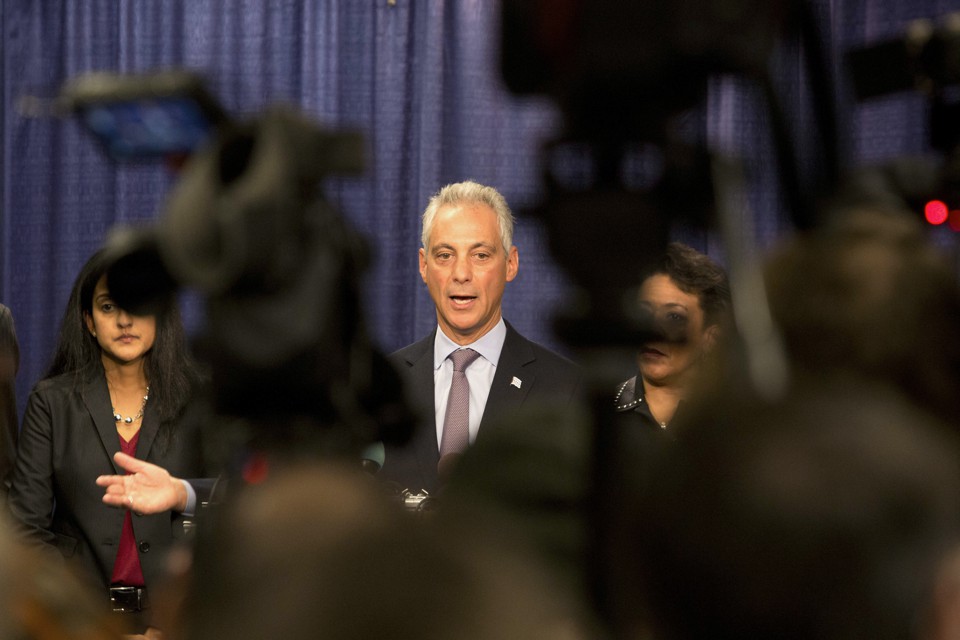 The results of the investigation into the Chicago Police Department’s use of force released Friday by the U.S. Department of Justice shows the city’s police engaged in systemic practices that violated residents’ constitutional rights. Here are some of the key findings from the report, which you can read in full here. The findings come 13 months after the investigation began, and more than two years since the fatal police shooting of 17-year-old Laquan McDonald, whose death—which was captured by police dash-cam footage and withheld by Chicago authorities for more than a year—prompted the inquiry.
The results of the investigation into the Chicago Police Department’s use of force released Friday by the U.S. Department of Justice shows the city’s police engaged in systemic practices that violated residents’ constitutional rights. Here are some of the key findings from the report, which you can read in full here. The findings come 13 months after the investigation began, and more than two years since the fatal police shooting of 17-year-old Laquan McDonald, whose death—which was captured by police dash-cam footage and withheld by Chicago authorities for more than a year—prompted the inquiry.The report’s release comes a month after the city announced that there were 762 were homicides in Chicago in 2016—more than Los Angeles and New York combined. Only 29 percent of these cases resulted in police identifying the suspected killer—a clearance rate less than half of the national average, the report pointed out. Here are some other key findings:
Unlawful use of deadly force against individuals who pose no threat
The investigation uncovered numerous incidents of police officers using deadly force against individuals who were unarmed or posed no immediate threat. Some of these incidents, the report notes, were initiated as foot pursuits “without any basis for believing the person had committed a serious crime.”
Unlawful use of less-lethal force
In cases where less-lethal force, such as tasers, was used, the investigation also uncovered evidence of unlawful or retaliatory conduct, noting that some officers “resort to Tasers as a tool of convenience, with insufficient concern or cognizance that it s a weapon with inherent risks that inflict significant pain.” Chicago Mayor Rahm Emanuel said the department will equip every officer with Tasers, though evidence does not suggest they reduce officer-involved shootings.
Unlawful use of force in cases of health crises
Though law enforcement is often the first to respond in cases of mental or behavioral health crises, the investigation found that officers use force against people in crisis in cases where force could be avoided. A “meaningful number” of these instances, according to the report, were deemed unconstitutional.
Failure to address racially discriminatory behavior
The investigation noted that some police officers disproportionately target minorities, citing statistics that show the department used force against black Chicagoans 10 times more frequently than their white counterparts. The report also noted the routine use of racially discriminatory language targeting blacks and Hispanics.
Lack of sufficient officer training
Underlying the systemic issues within the department, the reports finds, is a lack of sufficient training and supervision for the approximately 12,000-member strong force. This includes the use of outdated and inconsistent materials, as well as insufficient instruction by field training instructors.
Lack of accountability
The lack of sufficient training is supplemented by a lack of proper procedures to ensure that officers are held accountable for possible cases of misconduct. In the five years preceding the Justice Department’s investigation, it found that less than 2 percent of 30,000 police misconduct complaints were sustained, with the remaining 98 percent resulting in no discipline. The report cites a number of systemic factors precluding misconduct investigations, including an unwillingness to investigate anonymous complaints, provisions in union agreements, and officers’ “code of silence” aimed at covering up misconduct.
Emanuel called the investigation’s findings “sobering” and pledged to negotiate an agreement with the Justice Department to achieve systemic reforms. It is unclear what impact such an agreement will have in the final days of President Obama’s administration. Jeff Sessions, President-elect Donald Trump’s pick for attorney general, voiced concern over police oversight investigations during his Senate confirmation hearing Tuesday, testifying that federal lawsuits against local law enforcement could “undermine the respect for police officers and create an impression that the entire department is not doing their work consistent with fidelity to law and fairness.”
Original Article
Source: theatlantic.com/
Author: Yasmeen Serhan
No comments:
Post a Comment